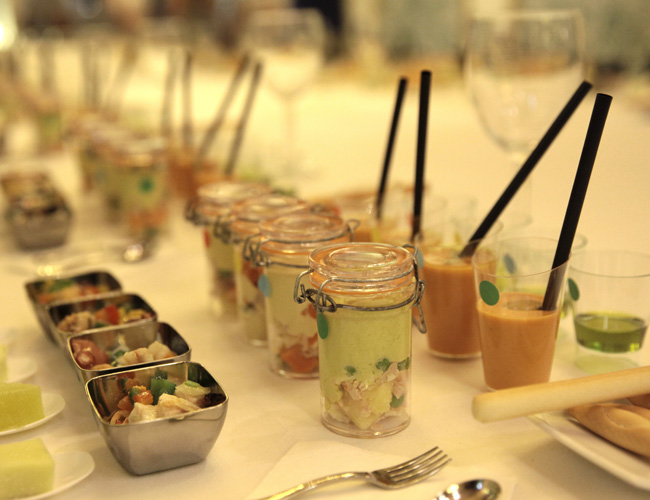A taste of Spain: joining college lecturers on a culinary showcase
College lecturers from the UK, Mexico, America and Hong Kong flew out to Spain for a culinary showcase of the country's most famous exports. Lisa Jenkins joined them
A spirited contingent of UK chef-lecturers set off on an expedition to find out more about Spain's finest culinary exports late last year, toasting the start of the odyssey in Madrid with a glass of tinto de verano, a cocktail made of Spanish red wine and La Casera (a lightly sweetened soda).
The lecturers were on a tour organised by Foods from Spain and ICEX Spain Trade and Investment. The itinerary included attending tastings and talks about Spain's most famous products so they could bring the knowledge back to the UK to their students.
The next morning saw the first trip: to Madrid's flagship El Corte Inglés, part of the biggest department store group in Europe, for an introduction to Spanish produce, which included a selection of crabs and lobsters much smaller than fishermen are allowed to catch in the UK.
This was followed by a tasting of gourmet tinned fish, led by Braulio Martinez, an instructor at Centro Superior de Hostelería de Galicia. "The use of tinned fish is not widespread among chefs in the UK," said Jose Souto, chef-lecturer in culinary arts at Westminster Kingsway College. Martinez described how the fish and shellfish are tinned without preservatives and simply covered in Spanish olive oil. The tinned fish is used as a tapas dish and the oil from the tins is used by the chefs to create brines and sauces.
That same afternoon the chefs headed off for an olive oil masterclass with Alfonso Fernández, courtesy of the Spanish Olive Oil Interprofessional Organisation, and for a tasting with renowned Spanish chef Alberto Moya of restaurant Mortadella in Madrid.
Spain produces more than a million tonnes of olive oil every year, and accounts for 60% of the world's olive oil harvest. The olive is a winter fruit harvested from mid-October, although the picking starts earlier in southern Spain. Every other year, an olive tree will produce less fruit, which leads to lower yield and potentially higher prices. It takes 1,000 olives to make a litre of oil, with the oils made using a centrifugal system that separates the flesh from the stone and oil.
The group tried four varieties of virgin olive oil: Picual, Hojiblanca, Arbequina and Cornicabra. The oils were served in blue glasses, which mask the colour of the oils so they are not pre-judged by their appearance. After warming the oils, Fernandez talked us through the flavours and aromas of the oils, which can include fresh-cut grass, tomatoes and tomato plants, apples, pears, citrus and tropical fruits, and nuts.
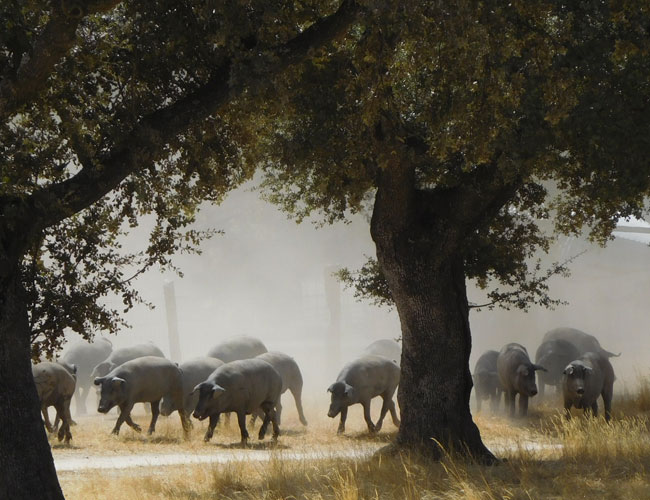
Pig out
The following day the lecturers travelled 400 kilometres south of Madrid to the heart of the Pedroches valley in CÁ³rdoba to visit the Ibérico pork production co-operative Covap. Founded in the 1930s by a group of farmers, the co-operative has developed to a considerable size, with more than 12,000 members.
The ancient 'valley of the acorns', as the Pedroches used to be known, covers 300,000 hectares of land and produces pork products such as ham, loins and shoulders. In October, at a minimum age of 12 months and with a weight of approximately 90kg, the Iberian pigs will enter the free-range Montanera stage of their rearing, living among the acorn trees. They stay there for five months, eating mainly acorns and some cereal, and by February will weigh on average between 160kg and 170kg - that's 50g of fat gained per day, and each pig will have eaten 10kg of acorns.
Once the pigs have reached their optimal weight, they are slaughtered quickly and with minimal stress. The carcasses are prepared using a hot butchering process - once the fat has cooled down it can make the carcass too difficult to butcher. The pigs are butchered into traditional cuts: the back legs to make jamÁ³n, the front shoulders to make paleta, the tenderloin and other cuts for chorizo and salchichÁ³n. Other parts of the carcass are used for presa, pluma and secreto. After cooling, the legs and shoulders are salted for one day per kg weight of the joint, plus an extra day.
Following the salting stage, the jamÁ³ns and paletas are brought to the upper floors of a drying room, and left to dry for at least a year. After this, they are moved to a maturation cellar, where the temperature is milder, for a further two years.
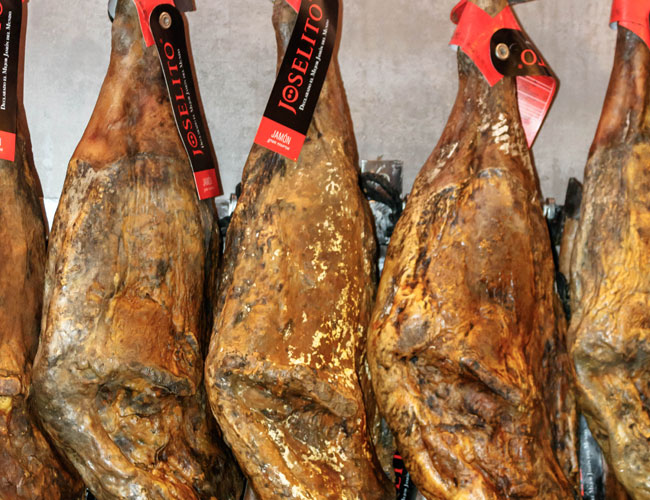
Not just Manchego
On day three, the group heads to Mercamadrid, Spain's largest fish and meat market, for a cheese and charcuterie masterclass by product expert and historian Enric Canut.
He explains how the various types of land in Spain are home to different types of cheese. The northern part of mainland Spain, from Galicia on the Atlantic to Cape Creus on Catalonia's Mediterranean coast, is 'green Spain', with abundant rain. Cows and sheep are the main animals in this area, and more than 50 types of cheese are produced here. The eastern coast, according to Canut, "is the realm of the goat, which has succeeded in colonising the wild slopes of open woodland and shrubland".
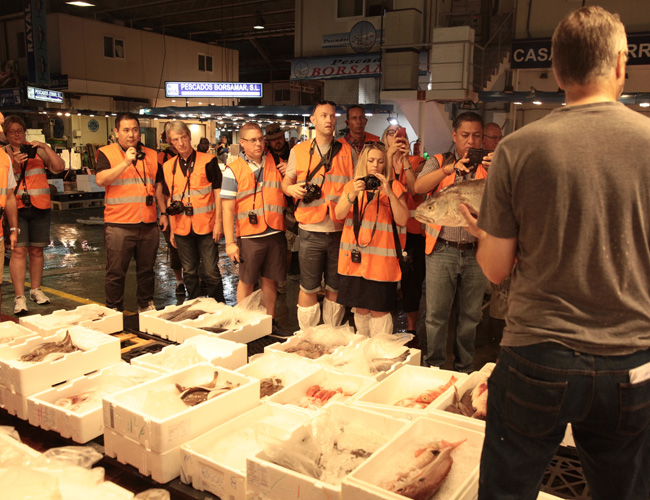
e interior of Spain is home to such fine breeds of sheep as the Merino and Manchega. The south-west (Extremadura and Andalusia) is made up of mountain ranges, valleys and inland plains, and is home to goats and sheep, and fresh and soft cheeses.
Lastly, there is the unique character of the Canarian archipelago, overlooking the west coast of Africa. With the highest point reaching up 3,718 metres, the Canaries are the natural home of the goat. The goats' cheese produced on the islands comes in natural and smoked varieties, flavoured with paprika, or covered with gofio (toasted cornflour).
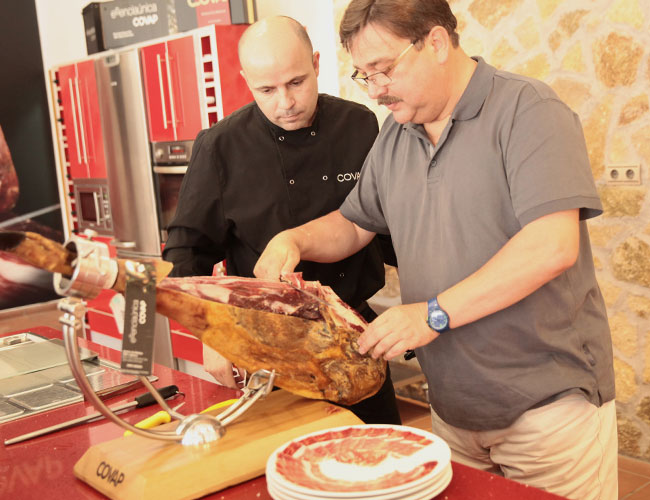
Back to Basque
The climax of the trip for most of the lecturers was a day in San SebastiÁ¡n in the north of Spain. The day started with a visit to the Basque Culinary Center, a renowned academic institution created by Basque chefs, the Mondragon University and an international council of chefs from Ferran AdriÁ , Joan Roca, Dan Barber and Heston Blumenthal.

A member of the teaching staff, chef Luis Arrufat, who worked for six years at elBulli, shows a selection of pintxos dishes in the school's state-of-the-art kitchen. The chefs made that pintxo classic, the gilda, incorporating olives, anchovies and pickled peppers (it was named after the 'spicy' film star Rita Hayworth), anchovies marinated in leche de tigre ('tiger's milk'), as well as cockles in marinade with wakame seaweed, oysters with sherry vinegar and Romescu sauce.

r last day was spent at the Bodegas Amézola de la Mora in Torremontalbo in La Rioja for a tour of the winery and a traditional Riojan lunch. The vineyard nestles under a mountain range, which protects the vines from the cold winds from the north.
Spain has a vibrant food scene, packed with new taste experiences (such as the hake neck we sampled in San Sebastian), but it's also based on old methods, traditions and recipes which showcase the freshness of the ingredients. The lecturers had been immersed in Spain's gastronomy - and all agreed they would take their knowledge back to their students with huge enthusiasm.

Look to the label
The labels on Iberico jamÁ³n can have several different meanings:
White label Can be several different pig breeds, farmed intensively, and killed at 12 months.
Green label Semi-intensively farmed pigs, mostly fed on cereal with a few acorns.
Red and black label Different breeds of pigs with some acorn feed, but for three months only.
Red label This pig's mother would be 100% Iberican, but the father only 50% Iberican. The pigs themselves are fed on acorns (de Bellota) for their last three months.
Black label 100% JamÁ³n Ibérico de Bellota.
Train the trainer
At Westminster Kingsway College in London, continuing professional development (CPD) means that both teachers and students benefit from a wider understanding of sustainability, provenance and supply issues.
Gary Hunter, vice-principal for hospitality and adult learning at Westminster Kingsway, says: "Unless we have the most recent knowledge available for our teachers to fully engage with, our students would be wasting their time coming to us. It is imperative that we facilitate learning that is both relevant and challenging.
"Our students are increasingly aware of cost and quality issues for products around the globe and closer to home. They understand there is much more to being a chef than just cooking in a kitchen, with a far-reaching responsibility for the environment, food waste, sustainability and provenance.
"If we invest in the lecturers, they will invest in our students, who will gain the rounded, work-ready knowledge that our industry needs. It certainly gives me a better and more flexible teaching team, supportive of each other, and able to share valuable experiences."
Jose Souto, chef-lecturer in culinary arts at Westminster Kingsway and author of Venison: The Game Larder, organises some of the educational trips. He says: "The visits give the team first-hand experience of a variety of products, which enables them to produce teaching materials that are up to date, interesting and topical.
"By going on these CPD trips the team's knowledge is vastly improved, giving them an understanding far beyond anything they could gain from a book or the internet.
"Chefs and front of house staff all benefit from additional learning that they pass on to their students, including new products, production and growing processes, and provenance. Students learn better when they have exciting, interesting and vibrant lessons - and lecturers."
Contacts
Braulio MartÁnez, Escuela de HostelerÁa de la Comunidad de Madrid
Basque Culinary Center
El Corte Inglés
Covap
Alfonso FernÁ¡ndez (olive oil seminar)
Enric Canut (cheeses and cured meats seminar)
Mortadella restaurant
Suppliers
Brindisa
Delicioso
Iberico Foods
Mevalco



